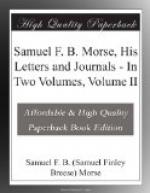To this letter Daguerre replied on July 26:—
MY DEAR SIR,—I have received with great pleasure your kind letter by which you announce to me my election as an honorary member of the National Academy of Design. I beg you will be so good as to express my thanks to the Academy, and to say that I am very proud of the honor which has been conferred upon me. I shall seize all opportunities of proving my gratitude for it. I am particularly indebted to you in this circumstance, and I feel very thankful for this and all other marks of interest you bestowed upon me.
The transaction with the French Government being nearly at an end, my discovery shall soon be made public. This cause, added to the immense distance between us, hinders me from taking the advantage of your good offer to get up at New York an exhibition of my results.
Believe me, my dear sir, your very devoted servant,
DAGUERRE.
A prophecy, shrewd in some particulars but rather faulty in others, of the influence of this new art upon painting, is contained in the following extracts from a letter of Morse’s to his friend and master Washington Allston:—
“I had hoped to have seen you long ere this, but my many avocations have kept me constantly employed from morning till night. When I say morning I mean half past four in the morning! I am afraid you will think me a Goth, but really the hours from that time till twelve at noon are the richest I ever enjoy.
“You have heard of the Daguerreotype. I have the instruments on the point of completion, and if it be possible I will yet bring them with me to Boston, and show you the beautiful results of this brilliant discovery. Art is to be wonderfully enriched by this discovery. How narrow and foolish the idea which some express that it will be the ruin of art, or rather artists, for every one will be his own painter. One effect, I think, will undoubtedly be to banish the sketchy, slovenly daubs that pass for spirited and learned; those works which possess mere general effect without detail, because, forsooth, detail destroys general effect. Nature, in the results of Daguerre’s process, has taken the pencil into her own hands, and she shows that the minutest detail disturbs not the general repose. Artists will learn how to paint, and amateurs, or rather connoisseurs, how to criticise, how to look at Nature, and, therefore, how to estimate the value of true art. Our studies will now be enriched with sketches from nature which we can store up during the summer, as the bee gathers her sweets for winter, and we shall thus have rich materials for composition and an exhaustless store for the imagination to feed upon.”
An interesting account of his experiences with this wonderful new discovery is contained in a letter written many years later, on the 10th of February, 1855:—




